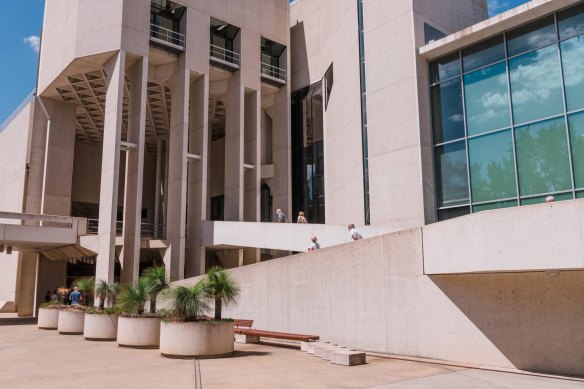This was published 1 year ago
NGA announces investigation into authorship of Indigenous art
By Linda Morris
The National Gallery of Australia has announced an independent review of the provenance of 28 Indigenous artworks due to be hung next month for a major exhibition of artists from the remote Anangu Pitjantjatjara Yankunytjatjara Lands (APY Lands).
While the review is underway, the Canberra-based institution has halted all promotion of the upcoming exhibition, Ngura Pulka - Epic Country, which opens in less than six weeks.

The National Gallery of Australia is investigating the authorship of work in its upcoming Ngura Pulka – Epic Country exhibition.Credit: James Brickwood
Leading Melbourne barrister Colin Golvan and Sydney lawyer, Shane Simpson, both experts in copyright law, will determine whether the exhibition paintings “can properly be described as having been made under the creative control of the persons named as the artists”.
Under its terms of reference, the inquiry will consider the scope and extent of any third-party contributions and, in particular, the involvement of studio assistants and managers at the APY Art Centre Collective to create the 28 paintings in the Ngura Pulka exhibition.
It will come to a view on whether those works were actually made under the creative control of the artists to whom they are attributed, and can make recommendations to the NGA’s director Nick Mitzevich based on its findings.
The NGA says the review will be released in full to the public, but notes it is not an “arbitral body” on broader ethical and cultural issues and says its focus was also to ensure the welfare and safety of the artists involved.
The review will not assess the broader ethics and workings of the First Nations’ art market, the significance of the Tjukurpa or cultural stories of the 28 paintings, and whether individuals who contributed to the 28 paintings were entitled to do so under relevant First Nations cultural laws.
The inquiry follows allegations published by The Australian that studio assistants had a role in the creation of Indigenous artwork at APY Lands Art Centre Collective’s Adelaide centre in a way that might have interfered with or overruled the artists’ visions.
The review has until May 31 to report back, two days before the exhibition, Ngura Pulka - Epic Country, is due to open on June 2. The NGA has billed the show as one of the largest and most significant First Nations community-driven art projects to have ever been developed.
The APY Art Centre Collective strenuously denies “the over-arching narrative” of those reports.
“We believe our professional studios meet the highest standards of integrity and professionalism,” the organisation said. “Assistants may or may not take part in the process of underpainting to some degree, at the artist’s direction.”
Underpainting was described by the Art Centre Collective as the process where heavily diluted paint is poured, sprayed, or slopped onto the canvas, often with large painting brushes. Multiple layers are then applied by the artist only.
Golvan and Simpson will be advised by Yhonnie Scarce, a Kokatha and Nukunu artist, and Professor Maree Meredith, a Bidjara woman and the University of Canberra’s Pro Vice-Chancellor Indigenous Leadership.
This masthead has also approached the National Gallery of Victoria, Art Gallery of NSW and Art Gallery of South Australia to determine if these institutions are undertaking similar reviews of works they hold.
All hold significant collections of work from the Anunga people of the APY Lands.
NGA director Nick Mitzevich said in a statement: “The aim of the independent review is to clarify whether the Anangu Pitjantjatjara Yankunytjatjara (APY) artists attributed as the creators of the paintings to be included in the gallery’s upcoming Ngura Pulka exhibition exercised effective creative control over the creation of the paintings, and so can properly be described as the artists responsible for those works consistent with the National Gallery’s provenance policy.
“At this point, our focus is ensuring the welfare and safety of artists and seeking independent and expert assistance to assess the provenance of the 28 works on loan to the National Gallery for Ngura Pulka.”
The report’s recommendations will be considered by the National Gallery of Australia’s council. Indigenous artist Sally Scales has declared a conflict of interest as a Director of APY Gallery and as an exhibition artist and has recused herself from any council deliberations around the exhibition.
A cultural guide to going out and loving your city. Sign up to our Culture Fix newsletter here.
.